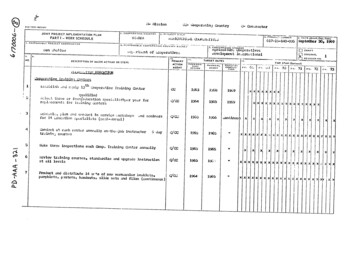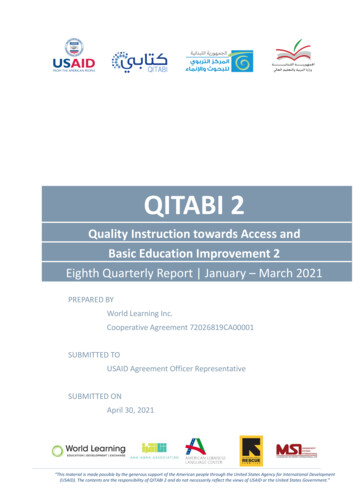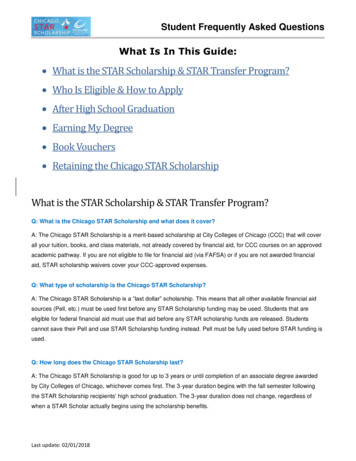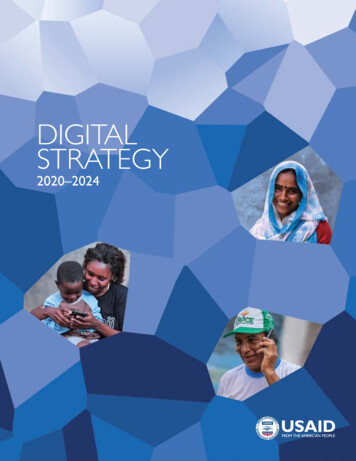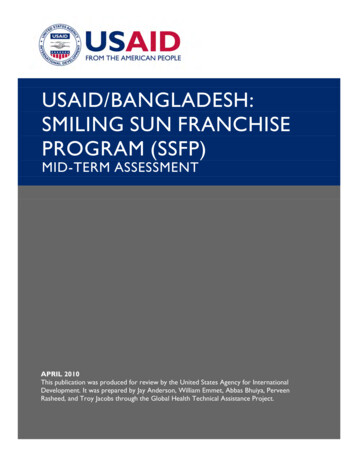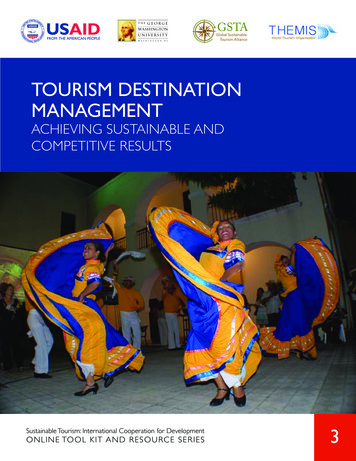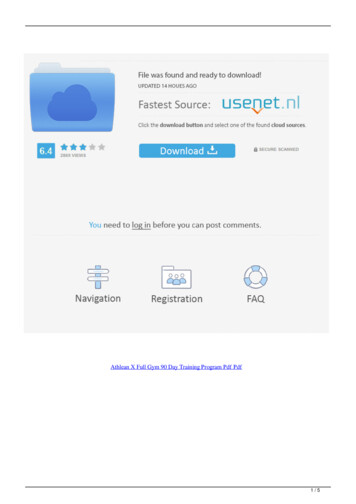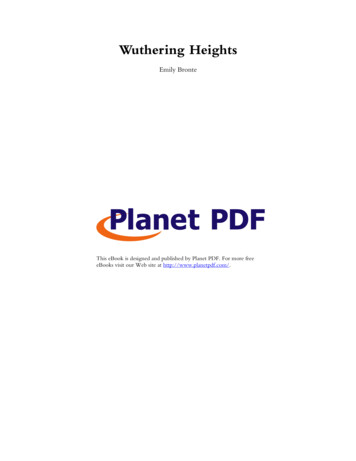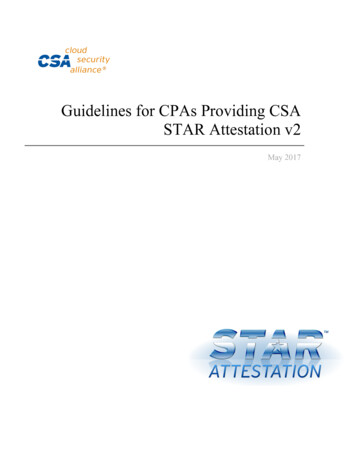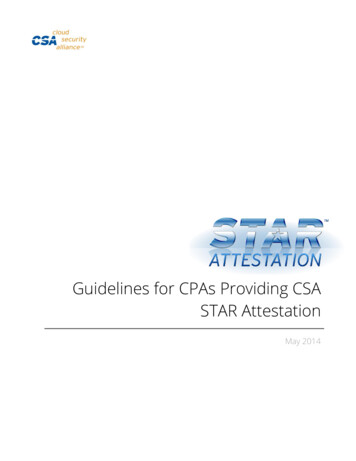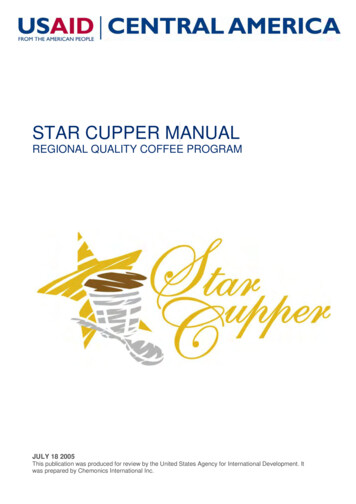
Transcription
STAR CUPPER MANUALREGIONAL QUALITY COFFEE PROGRAMJULY 18 2005This publication was produced for review by the United States Agency for International Development. Itwas prepared by Chemonics International Inc.
STAR CUPPER MANUALREGIONAL QUALITY COFFEE PROGRAMCentral America & Dominican Republic Quality Coffee ProgramRAISE Indefinite Quantity ContractContract No.: PCE-I-00-99-00003-00, T.O. 816The author’s views expressed in this publication do not necessarily reflect the views of theUnited Sates Agency for International Development or the United States Government.
TABLE OF CONTENTSINTRODUCTIONBackground11Objective1What Made the Star Cupper Program a Success?2Company Involvement2Mandatory Attendance2Punctuality2Periodic Examination2Duration of the Course2Course Facilitator3Training by Experts3Twenty (20) Hours of Service3Cupper Selection3Pre-examination4Star Cupper Classes5Training5Teacher’s Manual5CLASS O N E7Part A: Introduction to the Star Cupper Training Course7Objective7Exercise 17Exercise 27
Part B: The Coffee ”C” Exchange7Objective7Requirements8Part C: The First Calibration8Objective8Exercise 18Calibration8Part D: 20 Service Hours HomeworkConclusion1010CLASS T W O11The Specialty Coffee Market, SCAA and Calibration11Part A: The Specialty Coffee Market11Objective11Requirements11Part B: Cupping Protocols11Objective11Exercise 1: CADR Norms & Standards Puzzle11Exercise 2: SCAA Cupping Protocol Puzzle12Exercise 3: SCAA Cupping Form12Exercise 4: Cupping12Materials12Part C: Cupping of Regional Coffees by CountryExercise 4 through 6: Cupping of Regional Coffees byCountryPart D: 20 Service Hour Homework121212Conclusions13CLASS T H R E E14Coffee Processing and Sensory Analysis14Part A: Wet Milling14Objective14
Requirements14Exercise 114Part B: SCAA Sensory Skills Protocol and Test14Objective14Exercise 114Exercise 214Exercise 314Part C: Public Speaking Presentations15Objective15Exercise 115Part D: 20 Service Hour Homework15CLASS F O U R17Green Grading and Triangulation17ObjectivePart A: GCA Green Grading Protocol1717Objective17Materials17Exercise 117Exercise 217Part B: SCAA Green Grading Protocol17Objective17Materials17Exercise 117Exercise 218Part C: Triangulation18Objective18Exercise 118CLASS F I V E19How to be a Teacher?19Objective19
Exercise 1: Pair Interviews19Exercise 2: Semáforo19Exercise 3: Coat of Arms19Exercise 4: Carrousel20Exercise 5: Presentation on Pedagogy20Exercise 6: Public Speaking Presentations20Exercise 7: Puzzle20Exercise 8: Final Thoughts and Closing20CLASS S I X22Roasting and Blending22Objective22Requirements22Exercise 122Exercise 222Exercise 322Exercise 4: Grinding23Exercise 5: Blending23Exercise 623Exercise 7: Roast and Blend Competition23Conclusion23CLASS S E V E N25The Cupping Laboratory and Statistical Analysis25Objective25Requirements25Exercise 125Exercise 225Conclusion25COURSE C O N C L U S I O N26Acknowledgments27References28
ANNEXESIntroAttachment 1: Examen TeóricoClass One30303030Attachment 1: “Mercado Internacional de Café” PowerPoint Presentation30Attachment 2: “Procedimiento para calificación y emisiónde noticias de certificación de café” PowerPoint Presentation30Attachment 3: Basic Cupping Form30Attachment 4: A Coffee Taster’s Glossary30Attachment 5: Example Class Evaluation Form30Attachment 6: Example Class Agenda30Class Two30Attachment 1: Examen for NY Bolsa30Attachment 2: “Mercado Especializado Productos yTendencias” PowerPoint Presentation30Attachment 3: CADR Norms & Standards Guide30Attachment 4: Basic Cupping Form30Class Three30Attachment 1: Product Development Exam30Attachment 2: “¿Qué es un Catador?” PowerPointPresentation30Attachment 3: Coffee Topics30Attachment 4: Service Hours Proposal & Contract30Attachment 5: Service Hours Completion Form30Class Four30Attachment 1: Wet Milling Exam30Attachment 2: GCA Green Grading Protocol Presentation30Class Five30Attachment 1: Green Grading Exam30Attachment 2: What a Teacher Thinks 30Attachment 3: William Glasser Active vs. Passive Activity30
Attachment 4: Teacher Cheat Sheets30Attachment 5: Presenter Evaluation Form30Attachment 6: Lessons Learned Exercise (English)30Attachment 7: Lessons Learned Exercise (Spanish)30Class SixAttachment 1: How to be a Teacher ExamClass Seven303031Attachment 1: Roasting Exam31Attachment 2: “Control Estadístico en el Café” PowerPoint Presentation31
INTRODUCTIONBACKGROUNDThe Central American and Dominican Republic Quality Coffee Program (QCP), and initiative of theUnited States Agency for International Development (USAID) implemented by Chemonics InternationalInc, was a regional initiative to assist Central American countries and the Dominican Republic compete inthe upscale segments of the coffee market. The comparative advantage of Central America and theDominican Republic is in producing high quality coffee. The overall strategy for USAID’s work in thissector was to promote rural prosperity by increasing the competitiveness of small and medium-sizedproducers of quality coffee, and by diversifying the rural economy. Enhanced quality and productivity,improved business linkages, market-oriented policies, and sound environmental management wereessential elements of the program.QCP began in January 2003 and was implemented until September 2005, during which time the programdeveloped numerous activities for each country in the region. One of the main components of QCPfocused on coffee quality development through training. Throughout the research phase of the project itbecame apparent that coffee was being assessed differently by coffee tasters and laboratories in theregion. In order to create the foundation for consistent quality assessment throughout the region it wasnecessary to create norms and standards on measuring coffee quality. Cuppers needed to measure coffeeon the same scale from excellent to poor and to determine defects in the same manner, and gatheringcuppers from Central America facilitated the creation of norms and standards and each cupper could becalibrated on the same scale. Throughout the process a common language was developed to unify theregion and facilitate a greater exchange of information between buyers and sellers. These norms andstandards would provide buyers with the confidence that sellers understood and met an internationallyrespected standard for quality coffee and producers and companies in the region would benefit from thisincreased confidence.In August 2003, QCP met with a representative of the Coffee Quality Institute (CQI), a non-profit trustaffiliated with the Specialty Coffee Association of America (SCAA), to discuss the creation of a trainingprogram which would help CQI raise the skills of local graders to measure the coffee destined for sale inthe Q auction platform. While QCP agree to work collaboratively with CQI to assist in preparing thecuppers for a Q Grader test, the project’s objective was more specific, to enhance the cupping capabilityof cuppers at origin.OBJECTIVEQCP’s objective was three-fold: first, to provide regional cuppers theoretical knowledge in all aspects ofthe international coffee market in order to increase their level of professionalism and to begin to bringthem on even footing with cuppers elsewhere in the world. This would enable them to increase theircontribution to their companies. Second, QCP worked to facilitate the calibration of cuppers throughoutthe region and to develop a set of regional norms and standards. And, third, QCP aimed to train the
cuppers to become teachers in order to transmit their newfound knowledge and in turn be consideredexperts in their field. Through this process, QCP’s goal was to establish the professional “Star Cupper”credential for graduates of the training program.WHAT MADE THE STAR CUPPER PROGRAM A SUCCESS?The success of the Star Cupper program can be attributed to a number of factors, however this reportwill focus on the considerations which should be taken into account during the preparation of follow-onStar Cupper training.COMPANY INVOLVEMENTThe support of one’s employer was a primary prerequisite for application to the Star Cupper program,and the commitment on the part of one’s company was required in writing. This support wasindispensable as the employer needed to understand that the participants in the training program wouldbe absent from work for a number of days and would additionally require the financial assistance of theiremployers to attend the classes, many of which were held outside the participant’s home country. Mostcompanies were very supportive, but some cuppers did have to pay their own expenses. In the future,QCP recommends the continued practice of requiring a written commitment from the applicant’s placeof employ.MANDATORY ATTENDANCEIn general training courses in Latin America have a tendency to be lenient on issues of attendance andpunctuality. From the outset, the cuppers were informed that attendance at the training courses wasmandatory except in the event of an emergency, at which point participants needed to call, email or faxthe reason why they would not be able to attend the class. This attendance policy established a tone ofseriousness and professionalism for the course, and it impressed upon the cuppers the need to take thecourse seriously and to organize their work in such a way as to allow them to attend. Particular difficultywas experienced during the coffee harvest season as occasionally students were not able to attend due toresponsibilities at work imposed by their supervisors. In this event cuppers were provided some leeway,but their supervisors were well aware of the importance of their employees’ attendance at the class.PUNCTUALITYTraining participants were furthermore required to sign a contract stating that they would be on time andif they were tardy by more than twenty (20) minutes, they could be sent home for the day.QCP required class participation by all training participants both during the sessions and in set-up, cleanup and other tasks necessary to make each class a success. This requirement engendered a sense ofownership of the Star Cupper Program by the cuppers themselves, and lent itself to a greater degree ofresponsibility and involvement by the participants themselves.Moreover, cellular telephone use was prohibited during the sessions. Two breaks during the day and thelunch hour were reserved for checking messages and making telephone calls.PERIODIC EXAMINATIONAt the beginning of each class an examination was administered on the material presented during theprevious class. These examinations proved critical to ensuring that the cuppers paid attention during theclasses, reviewed the material afterwards, and learned it well enough to be quizzed on it. Although manyparticipants failed exams at the beginning of the course, most commented that the exams made them takethe course much more seriously, thereby enabling them to learn much more.DURATION OF THE COURSEIn comparing the first generation Star Cupper course, which lasted one (1) year, and the second coursewhich lasted five (5) months, it became very clear that the year-long program was much more effective inpromoting unity, exchange of information throughout the region, and professional development. The2CLASS THREE
first course was composed of nine (9) monthly or bimonthly classes, in which more topics were able to becovered and the month or two in between allowed the cuppers to put their new skills and knowledge intopractice. After a few sessions the cuppers began to solidify as a group and to develop a professionalnetwork amongst themselves. One of the most important highlights of the course was that for the firsttime cuppers from various countries were able to get together periodically to exchange views and ideas ontopics related to their profession, a process which has led to the development of the strong Star Cuppernetwork within the region. The network established by the first generation of cuppers was strengtheneddue to the fact that they were afforded a longer training period and five (5) more classes than the secondgeneration of cuppers. Moreover, their dedication over a year-long period served as a testament to theirprofessional commitment and made their sense of achievement that much greater. In light of thisobservation, QCP strongly recommends that any new Star Cupper program be at least one (1) year induration.COURSE FACILITATORThe presence of a course facilitator who participated throughout the duration of the course was criticalfor ensuring the flow and continuity of the training program. The facilitator was responsible for settingthe tone of the course and ensuring compliance with regulations such as punctuality, attendance andexaminations. Whereas each class instructor participated during his/her class, the facilitator established along-term relationship with the group and ensured the progression of the course. QCP believes that adedicated course facilitator is essential for ensuring that the course proceed in an integrated nature, ratherthan as a series of isolated information sessions. QCP recommends that any new program have afacilitator who shepherds each generation of Star Cuppers from beginning to end, in addition to theindividual experts who lead each class.TRAINING BY EXPERTSStar Cupper classes were led by experts in their field, an important criterion which proved very importantfor challenging the already skilled cupping professionals. The experts provided the content for the StarCupper program and made each class unique in that each presenter had complete command of his/hertopic. QCP recommends that the future Star Cupper generations be provided with the same expertinstruction to ensure that students learn first-hand from the best of the best.TWENTY (20) HOURS OF SERVICEAll of the participants were required to provide twenty (20) service hours to their home country byproviding a training class to other individuals involved in the promotion of the consumption orproduction of quality coffee. The process of organizing a training event, preparing a presentation, andadministering a training session was transforming for the cuppers. They began as students and ended asteachers in their own right. Through these service hours, the Star Cuppers acquired self-confidence andachieved positions of leadership in their communities. Moreover, the Central American region as a wholebenefited from a multiplier affect of this training, as the 96 original Star Cuppers provided training toapproximately 1400 members of the quality coffee industry.CUPPER SELECTIONFrom the beginning it was clear in order to make the most significant impact, QCP needed to work withthe best cuppers for each country. Therefore, the program partnered with each of the nationalorganizations: Consejo Salvadoreño de Café, Instituto Hondureño de Café, Instituto de Café de CostaRica y Associación Nacional del Café de Guatemala, Asociación de Cafés Especiales de Nicaragua and theSpecialty Coffee Association of Panama.The initial selection criteria required cuppers to have at least three (3) years of experience working in acupping capacity. Moreover, the cuppers were required to demonstrate the backing of their employersand to undergo a series of preliminary cupping and theoretical exams.INTRODUCTION3
In September 2003, the announcement was made throughout the region that the Star Cupper programwould be traveling to each country to select the ten best cuppers. In October 2003, QCP held preliminaryexaminations in Guatemala, Salvador, Honduras, Costa Rica and Nicaragua. Cuppers from Panamaparticipated in the second generation of Star Cuppers which began in January 2005.PRE-EXAMINATIONThe pre-examination comprised three parts:1. Theoretical knowledge. A written exam was administered to test theoretical knowledge on generalsubjects related to coffee such as agriculture, production, processing and trade. This test was instrumentalin weeding out individuals with limited formal education. It had been determined that Star Cuppers wouldneed to have achieved a level of schooling which allowed them to read and write at a high-school level.Some college education was preferable. (See Attachment 1: Examen Teórico)2. Sensory skills. The SCAA Sensory Skills Protocol and Test was adapted for use in the Star CupperTraining program. The methodology involved the use of basic flavors such as salt, sugar and citric acid todetermine how well the individual’s palette could identify flavors. The first two components of this testwere basic, requiring only recognition and placing flavors in order of intensity. The third was the mostcomplex and required the identification of various intensities in mixtures where some flavors masked thepresence of others. SCAA’s Sensory Skills Protocol and Test are not included herein, but are availablethrough SCAA. Rather, the concept is discussed in general terms for the purposes of orienting theTeacher as to the content of this portion of the course.3. Triangulation. In addition, the SCAA provides a Triangulation Skills Protocol and Test, which wasadapted for use in the Star Cupper Program. The practice of triangulation is not a new one, and it is usedfrequently in coffee cupping and in wine tasting. This third test evaluated the cuppers’ ability to perceivedifferences between three coffee samples. Two of the cups were prepared from the same sample, and thethird from a different sample. The cupper was required to identify the dissimilar sample. Specificinformation about the SCAA Triangulation Protocol and Test are available through SCAA.All of the examinations were scored as to the percentage of correct answers and the scores for eachapplicant were totaled. In the case of the first generation of Star Cuppers, the ten applicants from eachcountry receiving the highest scores were selected. In the case of the second generation, the top sevenwere selected. In the event that two people from the same company scored among the top ten, the higherscoring individual was selected so as not to have more than one person from any given company in theprogram. Tables 1 and 2 below illustrate the pre-examination results, country-by-country selection ofparticipants, and eventual graduation of the 2003 and 2005 Star Cupper programs, respectively.TABLE 1. RESULTS OF 2003 PRE-EXAMINATION AND GRADUATIONCountryGuatemalaEl SalvadorHondurasNicaraguaCosta men001214TABLE 2. RESULTS OF 2005 PRE-EXAMINATION AND GRADUATIONCountryGuatemalaEl Salvador4CLASS ated9101171553
HondurasNicaraguaCosta RicaPanamaTOTAL111717107968964602015578441STAR CUPPER CLASSESThe training course covered a wide variety of topics and included classes on the following topics: The Function of the Coffee “C” market as the foundation of the coffee market and its worldwideexchange. This class provided the basis for understanding the importance of coffee as a widelytraded commodity. It also provided an explanation for the annual fluctuation of coffee prices. The Specialty Coffee Market. Specialty coffee market trends, consumer issues and tradeinformation. This class served as an introduction to the fundamentals of Specialty Marketopportunities and the importance of quality. Coffee Processing. This class on production covered both the wet and dry stages of coffeeprocessing and how each contributes to quality. It served as a review for most of the participants,but also provided information on the latest technologies in wet and dry milling with specialemphasis on the role cupping plays in the mill. Cupper Calibration. This class session was geared toward the calibration of cuppers in tastingboth Central American and international coffee origins. Cupping sessions were held throughoutthe training program and were always calibrated to push cuppers to evaluate coffees on a similarscale. Green Grading. This class focused on the classification
Exercise 3: SCAA Cupping Form 12 Exercise 4: Cupping 12 Materials 12 Part C: Cupping of Regional Coffees by Country 12 Exercise 4 through 6: Cupping of Regional Coffees by Country 12 Part D: 20
